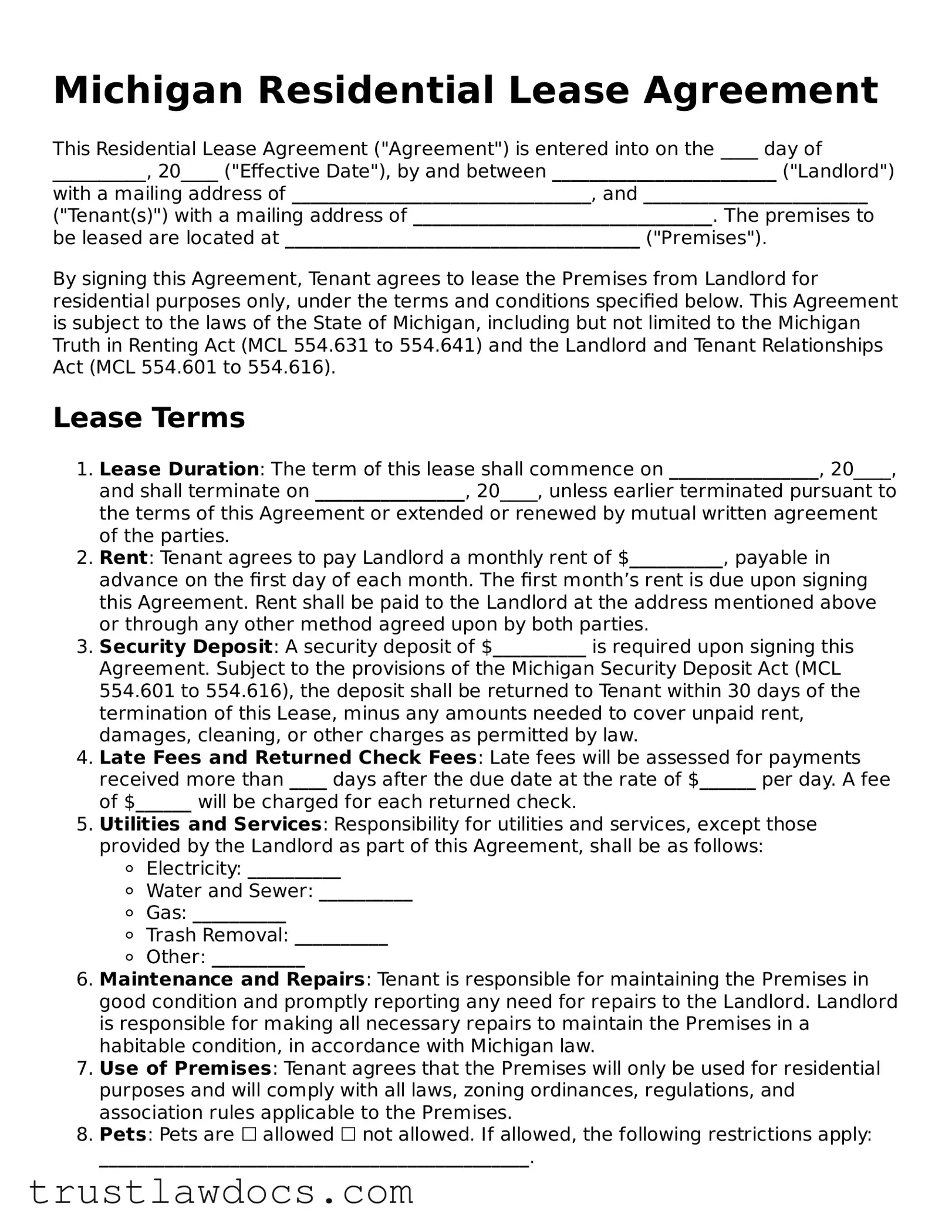The Michigan Residential Lease Agreement shares similarities with various other legal documents, each serving specific purposes within the realm of real estate and beyond. One such document is the Rental Application Form, which is typically filled out by prospective tenants before signing a lease. This form collects personal information, rental history, and financial status to assess whether the applicant is a suitable candidate for tenancy. Both documents are pivotal in the leasing process, but while the lease agreement formalizes the rental relationship, the application is a preliminary step in the tenant screening process.
Another document similar to the Michigan Residential Lease Agreement is the Sublease Agreement. This agreement is used when an original tenant wishes to rent out their leased premises, or a portion of it, to another tenant. Both agreements outline terms and conditions regarding rent, security deposit, and property use, but a sublease cannot be established without consideration of the terms set forth in the original lease agreement. Hence, the sublease rides on the coattails of the primary lease, operating within the permissions it grants.
A Room Rental Agreement is also akin to the Michigan Residential Lease Agreement, specifically when renting out individual rooms in a shared dwelling. It covers many of the same bases, such as rent amount and due date, but focuses on the specifics of living in shared spaces, including common area usage and house rules. While the residential lease typically involves a single family or tenant entity, room rental agreements cater to the nuances of cohabitation among non-family members.
The Lease Renewal Agreement mirrors the Michigan Residential Lease Agreement in its function to continue a rental relationship. Whereas the initial lease sets the groundwork for the landlord-tenant relationship, the renewal agreement extends the duration under the same or modified terms. This document signifies mutual satisfaction with the arrangement, allowing both parties to maintain the agreement without starting anew.
A Property Management Agreement, while broader in scope, shares the objective of maintaining and overseeing the proper use of rental property. This contract engages a property manager to handle day-to-day operations in exchange for a fee, covering aspects addressed in a lease agreement, such as rent collection and maintenance from a managerial perspective. While the lease deals directly with the tenant's rights and responsibilities, the management agreement outlines the roles and expectations of the property manager on behalf of the owner.
The Eviction Notice, though it might seem distinct, is related to the lease agreement as it signifies a breach of the terms agreed upon within the lease. This notice is a legal document landlords can use to begin the process of removing a tenant. It typically specifies the reason for eviction, such as unpaid rent or violation of lease conditions, underscoring the importance of adhering to the lease terms. The existence of the lease agreement gives the eviction notice its legal standing.
A Co-Signer Agreement is another document that parallels the Michigan Residential Lease Agreement by providing an additional layer of financial security for the landlord. This agreement makes another party, the co-signer, liable for rent or damages if the original tenant fails to meet their obligations. It supplements the lease by reinforcing the conditions under which the property is rented, specifically focusing on the financial aspects.
The Move-In/Move-Out Checklist complements the lease agreement by documenting the condition of the rental property at the time the tenant takes possession and upon departure. This checklist can help prevent disputes over security deposits and damages, making it an important accompaniment to the lease. While it doesn’t specify terms of tenancy, it plays a critical role in ensuring obligations about the property's condition are clear and agreed upon.
Lastly, the Landlord's Notice to Enter is a document that, while operational in nature, respects the tenancy established by the lease agreement. It notifies tenants when the landlord or their agents will enter the property for purposes allowed under the lease, such as inspections or repairs. This notice upholds the tenant's right to privacy while ensuring the landlord can maintain and inspect their property as necessary.
These documents, while each serving its unique purpose, collectively ensure that the rental process operates smoothly and that the rights and responsibilities of all parties are clearly defined and protected. From establishing the initial rental agreement to potentially ending or renewing that agreement, each plays a vital role in the ecosystem of property leasing and management.
